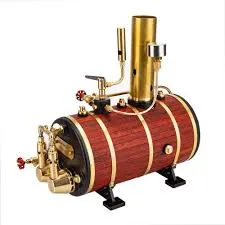
दिसम्बर . 24, 2024 10:54 Back to list
Understanding the Operation Principle of Thermal Oil Boilers for Efficient Heating Systems
Understanding the Working Principle of Thermal Oil Boilers
Thermal oil boilers play a crucial role in various industrial applications, providing an efficient and reliable means of heating. They operate on a unique principle that differs from traditional steam boilers, utilizing thermal oil as a heating medium. This article explores the working principle of thermal oil boilers, shedding light on their design, functionality, and advantages.
At the core of a thermal oil boiler system is the thermal oil, a specialized fluid designed to transfer heat effectively at high temperatures without the risks associated with high-pressure steam systems. The operating temperatures of thermal oil boilers can typically reach between 300°C (572°F) and 400°C (752°F) while maintaining low pressure, significantly enhancing safety and efficiency.
The fundamental working principle of a thermal oil boiler involves heat transfer through the thermal oil circulating in a closed loop. The process begins with the burner igniting and heating the oil within the boiler. The burner can be powered by various fuels, including natural gas, diesel, or biomass, depending on the energy requirements and operational preferences of the facility.
Once the thermal oil is heated, it circulates through a network of pipes to the heating system. The design of the boiler incorporates a heat exchanger, which is responsible for transferring the heat from the thermal oil to the desired application, such as an industrial process or a heat transfer unit. This heat exchanger can take several forms, such as shell and tube or plate-type exchangers, depending on the specific requirements of the application.
thermal oil boiler working principle

As the thermal oil circulates back to the boiler, it carries the heat energy away from the point of use, maintaining the temperature required for optimal operational efficiency. The continual circulation of the thermal oil ensures uniform heating and minimizes the risk of overheating, thus enhancing the safety of the system.
One of the key advantages of thermal oil boilers is their ability to operate at lower pressures than traditional steam boilers. This feature reduces the risk of catastrophic failures often associated with high-pressure systems. Additionally, thermal oil's high thermal capacity enables heat transfer without significant heat loss, contributing to the system's overall efficiency.
Moreover, thermal oil boilers are designed for easy maintenance and operation. The system typically includes features such as automatic controls and safety devices, which monitor the temperature and pressure levels. This automation not only streamlines operations but also enhances safety by mitigating the risks associated with overheating and overpressure.
Furthermore, the closed-loop system of a thermal oil boiler leads to minimal emissions as the thermal oil is reused within the system. This environmentally friendly approach aligns with modern sustainability goals, making thermal oil boilers a preferred choice for industries looking to reduce their carbon footprint.
In conclusion, thermal oil boilers are an essential component of many industrial heating processes, offering a blend of safety, efficiency, and reliability. Their unique working principle, based on the circulation of heated thermal oil, allows industries to achieve high temperatures while maintaining low pressure. With advantages such as reduced risk of accidents, lower emissions, and easier maintenance, thermal oil boilers are increasingly becoming a standard solution in various sectors, from manufacturing to food processing. As industries continue to prioritize efficiency and sustainability, the role of thermal oil boilers is likely to expand even further, underlining their importance in the modern industrial landscape.
-
Best Steam Boiler Design PDF Free Design Calculation & Diagram Downloads
NewsJun.10,2025
-
Hot Boiler Water Heater Efficient Heating Solutions for Home & Commercial Use
NewsJun.10,2025
-
Steam Boiler Safety Devices High-Quality Protection Valves
NewsJun.10,2025
-
Ultimate Steam Boiler Checklist for Safety & Efficiency
NewsJun.10,2025
-
Optimal Hot Water Boiler Temperature Setting Guide
NewsJun.10,2025
-
Effective Hot Water Boiler Chemical Treatment Protect & Maintain
NewsJun.09,2025
Related PRODUCTS






















